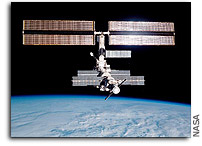NASA Space Station On-Orbit Status 6 September 2004

SpaceRef note: This NASA Headquarters internal status report, as presented here, contains additional, original material produced by SpaceRef.com (copyright © 2004) to enhance access to related status reports and NASA activities.
All ISS systems continue to function nominally, except those noted previously or below. Labor Day — also being enjoyed by Mike Fincke and Gennady Padalka who had a light workload.
The Science Officer conducted the remaining portion of the HEAT experiment, today activating the hardware for Step 2/Mode 1. Afterwards, the experiment was turned off and the MSG (Microgravity Science Glovebox) rack powered off.
CDR Padalka finished EVA closeout ops by discharging the second 825M3 Orlan backpack battery, then stowing it with the discharge unit in the DC1 docking compartment.
Gennady rebooted the Matryoshka server (BSPN), then transferred log files from the BSPN to the ISS Wiener laptop onto a PCMCIA memory card (using a program called ShellForKE) for subsequent downlink, afterwards again “cleaning out” housekeeping data from two BSPN folders. [Matryoshka, working automatically with its BSPN server, takes measurements in the SM and DC-1 docking compartment for studies of on-orbit radiation and long-term dose accumulation, using six SPD dosimeters deployed throughout the Russian segment as well as in a spherical body-simulating Matryoshka-R phantom and a human torso model outside on the SM hull, mounted there during EVA-9 on 2/27/04.]
|
Previous Reports ISS On-orbit Status [HQ] |
The CDR also conducted the periodic inspection of the BIO-5 Rasteniya-2 (“Plants-2”) experiment which researches growth and development of plants under spaceflight conditions in the Lada-5 greenhouse.
FE Fincke completed the routine status checkup of the autonomous PCG-STES010 (Protein Crystal Growth-Single Locker Thermal Enclosure System) payload in the Lab (done every Monday, Wednesday and Friday), and Padalka performed the routine inspection of the SM’s SOZh environment control & life support system.
Working off the Russian task list, Gennady began searching for and gathering hardware and tools required for the upcoming Elektron repair activities, to be conducted on the older BZh Fluid Unit #5. [The R&R will consist of a checkout of fluid breakthrough transducers, removal of gas bubbles from the electrolyte loop using an external circulation device (UTs), removal of gas bubbles from the micropumps (MNO & MNR) by flowing fluid through them, and activating the micropumps. Gear required besides the old BZh include a nitrogen purge unit (BPA-M), the Elektron checkout console, a hand pump, a pressure indicator, plus hoses, cables and adapters.]
The crew completed its daily physical exercise on TVIS treadmill, RED resistive exerciser, and VELO stationary bike with load trainer.
Yesterday at approximately 4:44pm EDT, control moment gyroscope 3 (CMG-3) exhibited vibrations spiking at 0.06g. Until this morning’s anomaly report, there had been no other spikes above 0.06g.
Expedition 9 Flight Crew Plans can be found at http://spaceflight.nasa.gov/station/timelines/
|
|
Previous NASA ISS On-orbit Status Reports can be found here. Previous NASA Space Station Status Reports can be found here. Previous NASA Space Shuttle Processing Status Reports can be found here. A collection of all of these reports and other materials relating to Return to Flight for the Space Shuttle fleet can be found here.
Today’s optional CEO photo targets, limited in the current XPOP attitude by flight rule constraints on the use of the science window, which is available for only ~1/4 of each orbit when not facing forward (in ram), were Hurricane Ivan, central Atlantic (Dynamic event. This storm was predicted to be a full hurricane at the time of this pass and is headed towards the Caribbean and the Gulf of Mexico. The eye should be visible approximately six to seven degrees right of track), and Internal waves, Tuamotu Archipelago (looking for a sunglint point to the left of track as ISS passed over the central archipelago. The presence of the islands may produce some interesting internal wave features).
CEO images can be viewed at these websites:
See also the website “Space Station Challenge” at:
To view the latest photos taken by the expedition 9 crew visit:
- http://spaceflight.nasa.gov/gallery/images/station/crew-9/ndxpage1.html at NASA’s Human Spaceflight website.
Major upcoming events:
- Reboost — 9/22 (phase angle correction for 9S)
- Soyuz 9S launch — 10/9;
- Soyuz 9S dock — 10/11;
- Soyuz 8S undock/land — 10/19;
- Soyuz 9S relocate — 11/18;
- Progress 16P launch — 11/24.
ISS Altitude History
Apogee height — Mean Altitude — Perigee height

For more on ISS orbit and worldwide ISS naked-eye visibility dates/times, see http://www.hq.nasa.gov/osf/station/viewing/issvis.html. In addition, information on International Space Station sighting opportunities can be found at http://spaceflight.nasa.gov/realdata/sightings/ on NASA’s Human Spaceflight website. The current location of the International Space Station can be found at http://science.nasa.gov/temp/StationLoc.html at NASA’s Marshall Space Flight Center. Additional satellite tracking resources can be found at http://www.spaceref.com/iss/tracking.html.










